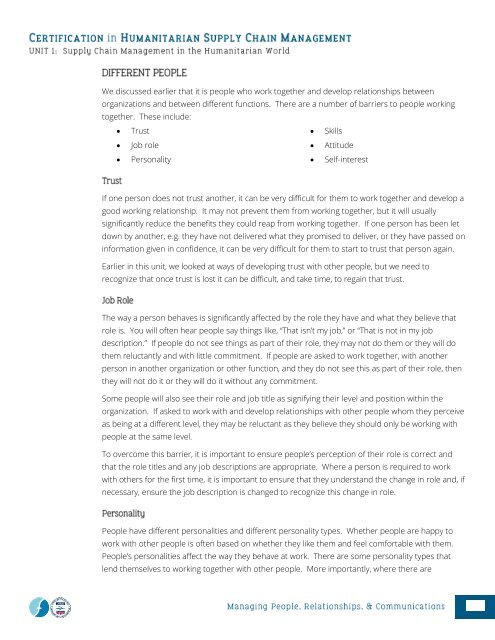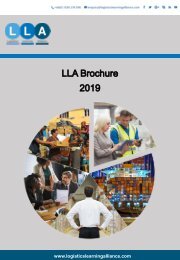CHSCM 3.0 - Unit 1 - SCM in the Humanitarian World
Learning Materials for Unit 1 of the Certification in Humanitarian Supply Chain Management (CHSCM).
Learning Materials for Unit 1 of the Certification in Humanitarian Supply Chain Management (CHSCM).
Create successful ePaper yourself
Turn your PDF publications into a flip-book with our unique Google optimized e-Paper software.
We discussed earlier that it is people who work toge<strong>the</strong>r and develop relationships between<br />
organizations and between different functions. There are a number of barriers to people work<strong>in</strong>g<br />
toge<strong>the</strong>r. These <strong>in</strong>clude:<br />
• Trust<br />
• Skills<br />
• Job role<br />
• Attitude<br />
• Personality<br />
• Self-<strong>in</strong>terest<br />
If one person does not trust ano<strong>the</strong>r, it can be very difficult for <strong>the</strong>m to work toge<strong>the</strong>r and develop a<br />
good work<strong>in</strong>g relationship. It may not prevent <strong>the</strong>m from work<strong>in</strong>g toge<strong>the</strong>r, but it will usually<br />
significantly reduce <strong>the</strong> benefits <strong>the</strong>y could reap from work<strong>in</strong>g toge<strong>the</strong>r. If one person has been let<br />
down by ano<strong>the</strong>r, e.g. <strong>the</strong>y have not delivered what <strong>the</strong>y promised to deliver, or <strong>the</strong>y have passed on<br />
<strong>in</strong>formation given <strong>in</strong> confidence, it can be very difficult for <strong>the</strong>m to start to trust that person aga<strong>in</strong>.<br />
Earlier <strong>in</strong> this unit, we looked at ways of develop<strong>in</strong>g trust with o<strong>the</strong>r people, but we need to<br />
recognize that once trust is lost it can be difficult, and take time, to rega<strong>in</strong> that trust.<br />
The way a person behaves is significantly affected by <strong>the</strong> role <strong>the</strong>y have and what <strong>the</strong>y believe that<br />
role is. You will often hear people say th<strong>in</strong>gs like, “That isn’t my job,’’ or “That is not <strong>in</strong> my job<br />
description.” If people do not see th<strong>in</strong>gs as part of <strong>the</strong>ir role, <strong>the</strong>y may not do <strong>the</strong>m or <strong>the</strong>y will do<br />
<strong>the</strong>m reluctantly and with little commitment. If people are asked to work toge<strong>the</strong>r, with ano<strong>the</strong>r<br />
person <strong>in</strong> ano<strong>the</strong>r organization or o<strong>the</strong>r function, and <strong>the</strong>y do not see this as part of <strong>the</strong>ir role, <strong>the</strong>n<br />
<strong>the</strong>y will not do it or <strong>the</strong>y will do it without any commitment.<br />
Some people will also see <strong>the</strong>ir role and job title as signify<strong>in</strong>g <strong>the</strong>ir level and position with<strong>in</strong> <strong>the</strong><br />
organization. If asked to work with and develop relationships with o<strong>the</strong>r people whom <strong>the</strong>y perceive<br />
as be<strong>in</strong>g at a different level, <strong>the</strong>y may be reluctant as <strong>the</strong>y believe <strong>the</strong>y should only be work<strong>in</strong>g with<br />
people at <strong>the</strong> same level.<br />
To overcome this barrier, it is important to ensure people’s perception of <strong>the</strong>ir role is correct and<br />
that <strong>the</strong> role titles and any job descriptions are appropriate. Where a person is required to work<br />
with o<strong>the</strong>rs for <strong>the</strong> first time, it is important to ensure that <strong>the</strong>y understand <strong>the</strong> change <strong>in</strong> role and, if<br />
necessary, ensure <strong>the</strong> job description is changed to recognize this change <strong>in</strong> role.<br />
People have different personalities and different personality types. Whe<strong>the</strong>r people are happy to<br />
work with o<strong>the</strong>r people is often based on whe<strong>the</strong>r <strong>the</strong>y like <strong>the</strong>m and feel comfortable with <strong>the</strong>m.<br />
People’s personalities affect <strong>the</strong> way <strong>the</strong>y behave at work. There are some personality types that<br />
lend <strong>the</strong>mselves to work<strong>in</strong>g toge<strong>the</strong>r with o<strong>the</strong>r people. More importantly, where <strong>the</strong>re are
















